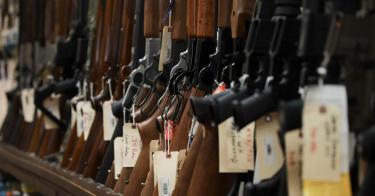As someone who works in Second Amendment policy, I often feel as though I have heard every bad, impractical or naïve gun-control argument that could possibly exist; in fact, it is becoming increasingly rare for me to find myself truly stunned at a statement made by a pro-gun control politician or advocacy group.
Yet even I was struck speechless when former Congressman Beto O’Rourke suggested during his presidential campaign that Americans would simply comply with his proposed laws to confiscate tens of millions of their firearms.
“If we’re able to pass mandatory buybacks and I’m able to sign that into law, then I fully expect our fellow Americans to turn in their AR-15s and AK-47s,” said O’Rourke.
This was not a misstatement or a one-off comment. As O’Rourke’s spokesman, Chris Evans, later confirmed: “When a mandatory buyback program for assault weapons is enacted, it is the law. We expect people to follow the law here in the United States, and we know that Americans are law-abiding people.”
I am not writing this to promote civil-disobedience, but just to point out fundamentals of human nature that ideologues like O’Rourke and Joe Biden don’t appear to appreciate. They seem to think the American people, or perhaps any group of people, will simply conform to whatever ideological framework they decide to legislate.
This isn’t true for many reasons.
First, non-compliance with gun-confiscation laws has been widespread even in countries that don’t protect the right of citizens to keep and bear arms.
Second, Americans are already notoriously non-compliant with strict gun-control measures in states that have enacted them on a smaller scale.
Third, the firearms and magazines that gun-control advocates wish to confiscate simply are not a driving force behind homicides—and America’s lawful gun owners know it. People rarely respond well to being scapegoated, and otherwise law-abiding gun owners aren’t likely to prove an exception to this rule.
Non-Americans Show Minimal Compliance
While gun-control activists in the U.S. regularly point to gun-confiscation programs carried out in other countries, they rarely highlight just how difficult a time these governments have in getting their citizens to comply with those orders.
Consider the minimal compliance recently shown by gun owners in New Zealand, which has no Second Amendment equivalent and where private gun ownership is considered a privilege instead of a right.
Last year, after a terrorist used a semi-automatic rifle to kill 51 unarmed worshippers in two Christchurch, New Zealand, mosques, the government almost immediately imposed sweeping new gun-control laws. Despite the fact that the country seldom breaks double digits for annual gun homicides and had not suffered from a mass-murder episode in over two decades, New Zealand banned the civilian possession of most semi-automatic rifles.
Since the newly banned rifles were not previously subject to registration requirements, it is unclear exactly how many of them were in civilian hands. The Council of Licensed Firearms Owners estimated, however, that New Zealanders possessed roughly 170,000 of them at the time of the ban. Owners of these firearms were required to submit to “mandatory buybacks,” a form of confiscation where the government reimburses the former gun owner for part of the gun’s value.
Gun-control advocates in the U.S. praised this confiscation effort and demanded similar action in the United States. Yet the New Zealand buyback has not gone smoothly.
Many New Zealanders simply refused to comply. By the end of February 2020, well after the final amnesty period ended in December 2019, police data indicated that only 57,000 firearms—about one-third of the total—had been turned in. The price tag: $67 million.
Worse, it appears that New Zealand managed to disarm only the most law-abiding of its citizens, none of whom posed a threat to public safety in the first place. Meanwhile, those citizens who were already prone to criminal activity continued to break the country’s gun laws. The head of a local gang candidly told reporters that his members would not turn in any of their firearms, because they needed those firearms to perpetuate gang-on-gang violence.
To add insult to injury, the New Zealand government failed to adequately protect gun owners’ confidential information, including bank account details. An estimated 37,000 firearm owners may have had their personal data breached through the New Zealand government’s official website for registering weapons turned in under the “buyback” law.
In a final assault on liberty, New Zealanders who initially voiced opposition to the law were targeted with police raids. In one case, a SWAT team stormed a man’s home over the possibility that the individual possessed a “tubular magazine” for a .22 LR lever-action rifle bearing little resemblance to a so-called “assault weapon.”
Such mediocre results for gun confiscation are not unique to New Zealand. Australia similarly banned the civilian possession of most semi-automatic firearms in 1996, but the country has spent the last two decades trying—and to a significant extent, failing—to enforce it.
Several reports from the early 2000s estimate that only 20% or so of the banned firearms had been confiscated. Non-compliance is so widespread that the Australian government has seen fit to repeatedly offer extra periods of amnesty, most recently in 2016, after a government report estimated there were still 260,000 “illegal” firearms in civilian hands.
Moreover, while firearm suicides dropped in Australia after the confiscation effort, there was little meaningful effect on the overall suicide rate. Another evaluation found no effect on homicides or accidental deaths, despite claims to the contrary.
Finally, consider the case of Canada when it tried to implement even the comparatively modest program of mandatory long-gun registration in 1997. The effort was initially slated to cost Canadian taxpayers $2 million. By 2002, however, the estimated cost had skyrocketed to over $1 billion. According to one study, fewer than half of the country’s long guns ended up registered.
Between 1997 and 2012, when the law was repealed, only three murders were committed where the accused person used a long gun registered in his own name under the law. Interestingly, rates of gun violence decreased faster in the United States over the same time period, despite the lack of federal gun-registration requirements.
Ontario Provincial Police Commissioner Julian Fantino bluntly stated the reality in 2003: “A law registering firearms has neither deterred [gun homicides] nor helped us solve any of them. None of the guns we know to have been used were registered.... The firearms registry is long on philosophy and short on practical results considering the money could be more effectively used for security against terrorism as well as on a host of other public safety initiatives.”
The current Canadian government has completely forgotten its disastrous foray into mandating stricter gun-control requirements, as it has now banned many popular semi-automatic firearms and, at press time, was moving toward some kind of gun-confiscation scheme.
Americans Are Notoriously Non-Compliant With Gun-Control Laws
If this type of significant and widespread non-compliance is so common in countries without America’s gun culture or constitutional protections for civilian gun ownership, it would be almost laughable to presume Americans would be more compliant with overbearing gun-control measures.
After all, civilian gun possession is deeply ingrained in the American psyche, as is an aversion to gun confiscation. The American Revolution itself officially ignited over an effort by King George III and his military generals to disarm the colonists; the battles at Lexington and Concord began because the British were coming to seize the colonists’ powder stores and render them defenseless against the armed enforcement of tyrannical laws.
Non-compliance with British gun-control mandates was widespread before and during the war. The Second Amendment was passed in large part as a counterbalance against government impulses toward tyranny, and an assurance against government attempts to create select militias with which to oppress a citizenry disarmed through arbitrary or burdensome gun-control laws.
It is hardly surprising, then, that even today, many otherwise law-abiding Americans fail to comply with laws they perceive as arbitrary infringements on their Second Amendment rights. Consider, for example, what happened when New York, in 2013, banned the future purchase of commonly owned semi-automatic rifles and required current owners to register their estimated 1 million “assault-style weapons” with the state.
Despite the threat of serious criminal penalties for non-compliance and extended periods of “amnesty,” by 2015 fewer than 45,000 firearms had been registered. In other words, it appears that tens of thousands of New Yorkers continue to simply ignore the law.
Similar rates of non-compliance have been observed for constitutionally suspect confiscation laws in other states; in fact, after New Jersey banned the civilian possession of standard magazines capable of holding more than 10 rounds, an investigation failed to discover a single instance where one of the state’s one million gun owners turned a prohibited magazine in to law enforcement authorities, as the statute required.
New Jersey and New York are states that historically have subjected their residents to much stricter gun-control measures relative to the rest of the country. If non-compliance is so widespread in states where residents are used to being subject to arbitrary and overbearing gun laws, there is no reason to believe that residents in more gun-friendly states would rush to turn in their rifles and magazines just because the federal government mandated it.
Lawful Gun Owners Know Their Rifles Aren’t the Problem
This widespread non-compliance can be explained by America’s historical aversion to gun control. But it can also be explained by the reality that Americans are increasingly aware of how gun-confiscation laws turn them into scapegoats without actually addressing the real problems.
Why? Because lawfully owned semi-automatic rifles are fundamentally not a driving force behind homicides in this country, or anywhere else.
Nearly two out of every three deaths by firearms in the United States are the result of suicide. In cases of suicide, neither gun type nor magazine capacity ultimately matter; moreover, while it is true that the U.S. has a fairly high rate of suicides committed with firearms, our overall suicide rate is relatively unremarkable compared with many countries with much stricter gun-control laws.
Semi-automatic rifles, such as the AR-15, are responsible for only a fraction of 1% of all gun deaths in the U.S. every year, while rifles of any kind account for about 3% of all gun homicides.
And finally, a majority of crimes committed with guns in the U.S. are carried out by individuals who are already prohibited from owning firearms—not by lawful gun owners.
In other words, lawful gun owners in the U.S. are not the problem. Confiscating their rifles and magazines is not a genuine, good-faith policy solution to save lives.
The rule of law has always been an important foundation of American society. But it is shockingly naïve for any politician or organization to expect millions of American gun owners to simply turn in to the government the very types of bearable small arms protected by the Second Amendment. It is even more naïve for them to believe that, even if we were to double the rate of compliance seen in other countries, there would be a profound effect on gun-related deaths in the U.S. because of it.
There are, of course, ways to further reduce violent crime and gun-related deaths in the U.S. States can and should, for example, continue to invest in adequate mental-health treatment for their citizens, in stopping the flow of illegal gun trafficking and in ensuring that more law-abiding citizens can defend themselves in more places.
But, if the government wishes to confiscate the guns of peaceable citizens, it should be prepared to find most Americans unwilling to comply—just as they were in 1775.
This piece originally appeared in America's 1st Freedom




